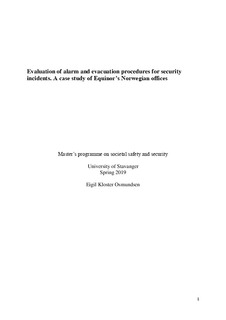| dc.contributor.advisor | Gould, Kenneth Arne Pettersen | |
| dc.contributor.author | Osmundsen, Eigil Kloster | |
| dc.coverage.spatial | Norway | nb_NO |
| dc.date.accessioned | 2019-11-15T09:30:35Z | |
| dc.date.available | 2019-11-15T09:30:35Z | |
| dc.date.issued | 2019-06-13 | |
| dc.identifier.uri | http://hdl.handle.net/11250/2628691 | |
| dc.description | Master's thesis in Risk management and societal safety | nb_NO |
| dc.description.abstract | Following a new threat assessment, Equinor has introduced a separate security evacuation drill once a year. From both theoretical and practical perspectives, the company faces a security trade-off. While it is crucial that personnel are ready and able to evacuate in an orderly fashion in the event of a shooter incident, the likelihood of such an incident is very low at a Norwegian office. If no known or suspected threats exist, therefore, a high level of evacuation drills may spread an unwarranted sense of fear in the organisation. One must consider the risk perception of the employees. Employees may infer a risk level from evacuation programmes and information campaigns which is considerably higher than the true figure. The potential downside of such fear is lower productivity and recruitment problems. However, an added value with evacuation drills at Norwegian offices, which should be taken into account, is that employees will be prepared should an incident occur when they are working at or visiting one of the company’s foreign offices in conflict areas, where the probability of an incident may be considerably higher. The same applies if employees encounter a dangerous situation on their private holidays.
This thesis sheds light on the various elements involved in this trade-off. The research question to be addressed by the thesis is thus as follows:
How should and does Equinor make the trade-off between providing the employees with a necessary level of skills relating to security threats and evacuation procedures on the one hand, and the possibility of generating fear among the personnel on the other?
The overall research question is thus two-dimensional:
(a) to teach the employees the necessary evacuation skills, versus
(b) avoiding generating unwarranted fear.
The overall research agenda is broken down into more specific research questions pertaining to this trade-off, representing controversial activities that may generate fear:
• Should Equinor have separate terror evacuation drills?
• Is it sufficient with e-learning programmes?
• Should drills and e-learning complement each other?
• How often should there be evacuation drills?
To analyse these issues I designed a questionnaire for Equionor employees, and I performed semi-structured interviews with key Equinor security stakeholders. | nb_NO |
| dc.language.iso | eng | nb_NO |
| dc.publisher | University of Stavanger, Norway | nb_NO |
| dc.relation.ispartofseries | Masteroppgave/UIS-TN-ISØP/2019; | |
| dc.rights | Navngivelse 4.0 Internasjonal | * |
| dc.rights.uri | http://creativecommons.org/licenses/by/4.0/deed.no | * |
| dc.subject | samfunnssikkerhet | nb_NO |
| dc.title | Evaluation of alarm and evacuation procedures for security incidents. A case study of Equinor’s Norwegian offices | nb_NO |
| dc.type | Master thesis | nb_NO |
| dc.subject.nsi | VDP::Social science: 200 | nb_NO |

